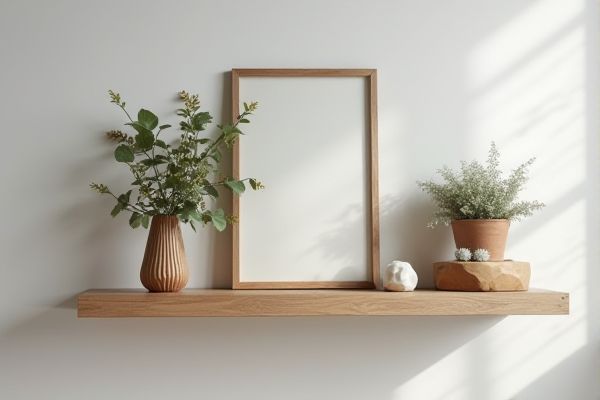
Floating shelves offer a sleek, minimalist look without visible brackets, making them ideal for modern spaces, while fixed shelves provide stronger support for heavier items due to their secure attachment to wall studs. Explore the rest of the article to determine which shelf type best suits your needs and enhances your home decor.
Table of Comparison
| Feature | Floating Shelf | Fixed Shelf |
|---|---|---|
| Installation | Hidden brackets; clean, modern look | Visible brackets or supports; traditional look |
| Weight Capacity | Typically lighter loads (10-30 lbs) | Supports heavier loads (up to 100 lbs+) |
| Design | Sleek, minimalistic; no visible hardware | Varied styles; hardware often visible |
| Installation Complexity | Requires precise wall anchoring | Generally easier and more forgiving |
| Cost | Higher due to specialized hardware | Lower; standard brackets and supports |
| Use Case | Display items, minimalist decor | Books, heavy tools, kitchen storage |
Introduction to Floating and Fixed Shelves
Floating shelves feature hidden brackets that create a clean, minimalist look by appearing to float on the wall, making them ideal for modern interior designs that emphasize seamless aesthetics. Fixed shelves are supported by visible brackets or side supports, providing robust strength suitable for holding heavier items and offering a classic or functional style. Your choice between floating and fixed shelves depends on the balance you want between visual appeal and load-bearing capacity in your space.
Key Differences Between Floating and Fixed Shelves
Floating shelves feature concealed brackets for a sleek, modern look, while fixed shelves use visible supports for greater stability and weight capacity. Floating shelves are ideal for light to medium loads and decorative purposes, whereas fixed shelves are better suited for heavy items and frequent use. Your choice depends on aesthetic preferences and the functional demands of your space.
Pros and Cons of Floating Shelves
Floating shelves offer a sleek, modern look by appearing to "float" without visible supports, maximizing floor space and providing easy wall cleaning. They are ideal for lightweight decor but may struggle with heavy items due to limited weight capacity compared to fixed shelves. Installation requires precise wall mounting to ensure stability, making fixed shelves a more reliable choice for robust storage needs in high-traffic areas.
Pros and Cons of Fixed Shelves
Fixed shelves provide sturdy support, making them ideal for holding heavy items like books or appliances without risk of sagging. Their permanence enhances stability but limits flexibility, as you cannot adjust shelf height or rearrange them easily to accommodate different storage needs. Your choice depends on whether you prioritize durability and strength over customizable space configuration.
Design Aesthetics: Floating vs Fixed Shelves
Floating shelves offer a sleek, minimalist design that creates an illusion of space by appearing to hover on the wall without visible supports. Fixed shelves, with their visible brackets or supports, provide a more traditional and sturdy aesthetic that suits classic or industrial interiors. Choosing between floating and fixed shelves depends on your preference for modern elegance or robust functionality in your room's design.
Installation Process: Floating Shelf vs Fixed Shelf
Floating shelves offer a sleek, modern look with concealed brackets, requiring precise wall anchors and studs for secure installation to support weight effectively. Fixed shelves typically involve visible brackets or supports attached directly to the wall, making installation straightforward but less minimalist in appearance. Your choice depends on the desired aesthetic and the ease of installation you prefer for your space.
Durability and Weight Capacity Comparison
Floating shelves offer moderate durability and typically support weight ranges from 20 to 50 pounds, depending on wall anchors and shelf materials, whereas fixed shelves provide enhanced stability and higher load capacities, often exceeding 100 pounds due to direct attachment with brackets or supports. Fixed shelves use robust mounting hardware anchored into studs, making them ideal for heavy items, while floating shelves rely on concealed brackets that may limit weight tolerance. When selecting between the two, consider the intended load requirements and the mounting substrate to ensure optimal shelf performance and longevity.
Best Use Cases for Floating Shelves
Floating shelves are ideal for modern and minimalist spaces where clean lines and open wall visibility are desired, making them perfect for displaying lightweight decor, small plants, or books without overwhelming the room. Your best choice for areas with limited floor space or where you want to create a visually spacious environment, as floating shelves offer versatility without bulky supports. These shelves work well in living rooms, bathrooms, and kitchens where practical storage meets stylish, unobtrusive design.
Best Use Cases for Fixed Shelves
Fixed shelves provide superior stability and weight-bearing capacity, making them ideal for storing heavy items such as books, kitchen appliances, or tools. They are best used in closets, garages, and pantries where permanent, durable storage solutions are required. Fixed shelves offer long-term support without sagging, ensuring safety and organization in high-traffic areas.
Choosing the Right Shelf for Your Space
Floating shelves offer a sleek, modern look with hidden brackets, ideal for minimalist designs and small spaces where open display is desired. Fixed shelves provide greater weight capacity and can be customized for heavy storage or built-in cabinetry needs, making them suitable for practical, robust use. Assess your room's style, storage requirements, and installation options to choose the right shelf that complements your space perfectly.
 homyna.com
homyna.com